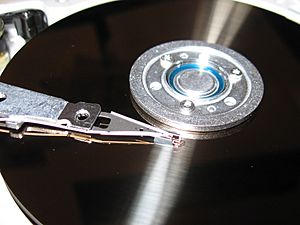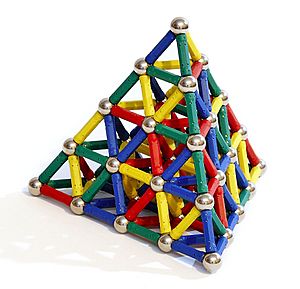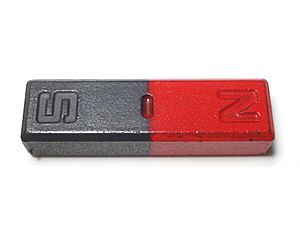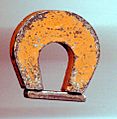Magnet facts for kids
A magnet is a special object that can pull or push certain metals and other magnets. This amazing power is called magnetism.
When you bring two magnets close, one of two things happens:
- If opposite sides (called poles) face each other, they will attract (pull together).
- If the same poles face each other, they will repel (push away).
Some metals can become magnets if you rub them with a strong magnet.
There are two main types of magnets:
- Soft magnets (also called temporary magnets) are often used in electromagnets. These magnets get much stronger when an electrical current flows through a wire wrapped around them. Their magnetic strength changes with the current.
- Permanent magnets keep their magnetism all the time. Some rocks, like lodestone, are natural permanent magnets. Most permanent magnets today are made by people. A magnet's strength can change with temperature: it gets weaker when heated and stronger when cooled.
Magnets are only attracted to certain metals. Metals like iron, cobalt, and nickel are magnetic. Steel is also magnetic because it contains iron. However, metals like brass, copper, zinc, and aluminum are not attracted to magnets. Materials like wood and glass are not magnetic either.
Contents
Natural Magnets and Earth's Magnetism
Natural magnets are rocks that are magnetic on their own. The most famous natural magnet is a rock called magnetite, also known as lodestone.
A compass is a great example of how natural magnetism works. A compass needle is a small magnet that points to the North magnetic pole because it reacts to the Earth's own huge magnetic field. It's a bit tricky, but the Earth's "North magnetic pole" is actually like the south pole of a giant magnet, and the "South magnetic pole" is like the north pole. This is why the north end of your compass needle (which is the north pole of that tiny magnet) points to the Earth's magnetic north.
The first people to discover naturally magnetic rocks were the Chinese. They first used these stones for magic tricks and fortune-telling. Later, they realized their practical use and used these "lodestones" to invent the compass, which helped them navigate.
How Magnets Are Used Every Day
Magnets are super useful and are found in many things we use daily!
Recording and Storing Information

- Magnetic recording media: Old VHS tapes and audio cassettes use magnetic tape to store video and sound. The information is saved on a special magnetic coating.
- Computer storage: Similarly, floppy disks and hard disks in computers record all your data on a thin magnetic layer.
- Cards: Your credit, debit, and ATM cards have a magnetic strip on the back. This strip holds important information to connect with your bank account.
In Electronics and Sound
- Older screens: Older televisions and large computer monitors (the ones that aren't flat screens) use electromagnets to guide electrons to the screen, creating the picture. Modern plasma and LCD screens use different technology.
- Speakers and microphones: Most speakers use a magnet and a coil of wire to turn electrical signals into sound. The coil moves because of the magnet, making the speaker cone vibrate and create sound. Microphones work the opposite way: they turn sound vibrations into electrical signals using a magnet and a coil.
- Electric guitars: Electric guitars use magnetic pickups to turn the vibrations of the guitar strings into an electric current. This current can then be made louder by an amplifier.
Power and Movement
- Electric motors and generators: Many electric motors use magnets to change electrical energy into movement. A generator does the opposite: it uses movement to create electrical energy by moving a wire through a magnetic field.
In Medicine and Industry
- Medicine: Hospitals use magnetic resonance imaging (MRI) to see inside a patient's body without needing surgery. This helps doctors find problems in organs.
- Holding things: Magnets are used in chucks and other devices to hold metal objects firmly in place, especially in metalworking.
- Separation: In factories, especially where food is made, magnets are used to remove tiny pieces of metal from raw materials or finished products. This helps keep the equipment safe and ensures the food is clean for you to eat.
Everyday Fun and Convenience

- Compasses: A compass is a simple tool with a magnetized needle that always points to the Earth's magnetic north, helping people find their way.
- Art: You can attach vinyl magnet sheets to paintings or photos to stick them on refrigerators or other metal surfaces. Magnetic art is easy to create and move around.
- Toys: Magnets are often used in children's toys, like building sets or levitating toys, because they can make things float or stick together in fun ways.
- Refrigerator magnets: These are popular for decorating kitchens, as souvenirs, or just to hold notes or photos on the fridge door.
- Picking up small items: Magnets can pick up small metal items like nails, staples, or paper clips that are hard to reach or too small for fingers. Some screwdrivers are even magnetized to help hold screws.
- Jewelry: Necklaces and bracelets can have magnetic clasps, or they can be made entirely from a series of magnets and metal beads.
Advanced Uses
- Maglev trains: Magnetic levitation transport, or maglev, is a type of transportation that uses powerful electromagnets to make trains float above the tracks. This removes friction, allowing them to travel at incredibly high speeds, like over 580 kilometers per hour (360 mph)!
- Safety cables: Some laptop power cords use magnets to connect. If someone trips over the cord, the magnetic connection simply breaks, preventing damage to the laptop or the port. The MagSafe power connection on Apple MacBooks is a good example.
Related pages
Images for kids
See also
 In Spanish: Imán para niños
In Spanish: Imán para niños






